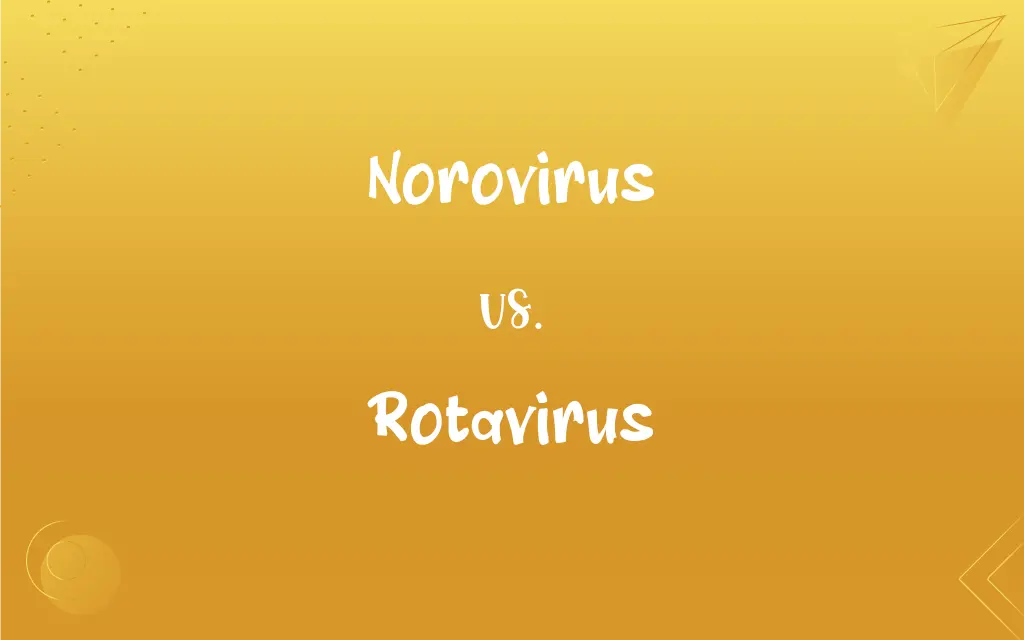Norovirus vs. Rotavirus: What's the Difference?
Edited by Aimie Carlson || By Janet White || Published on June 18, 2024
Norovirus causes acute gastroenteritis in all age groups, often from contaminated food, while rotavirus predominantly affects infants and young children, leading to severe diarrhea.

Key Differences
Norovirus and rotavirus are both highly contagious viruses that cause gastroenteritis, but they differ in their epidemiology and impact. Norovirus is known for causing outbreaks in closed environments like cruise ships and hospitals, affecting people of all ages. Rotavirus, on the other hand, is most notorious for its severe impact on infants and young children worldwide, leading to dehydration and hospitalization.
The symptoms of norovirus infection can include sudden onset of vomiting, diarrhea, and stomach cramping, and it is notorious for its rapid spread and ability to cause large outbreaks. Rotavirus symptoms are similar but are particularly severe in young children and are a leading cause of severe diarrhea and dehydration in this age group, leading to significant morbidity and mortality in developing countries.
Vaccination strategies differ significantly between the two viruses. While effective vaccines are available and recommended for rotavirus to prevent severe illness in children, there is no vaccine currently available for norovirus, making prevention focused on hygiene and sanitation measures to control its spread.
Norovirus outbreaks are more common in colder months in temperate climates and can affect both adults and children, leading to widespread illness in communities, healthcare facilities, and schools. Rotavirus also has a seasonal pattern, with peaks in colder months, but the introduction of rotavirus vaccines has led to a substantial decrease in cases in countries with high vaccination coverage.
The transmission of norovirus is through the fecal-oral route, often through contaminated food and water or direct contact with an infected person. Rotavirus also spreads via the fecal-oral route but has a higher prevalence in environments where access to clean water and sanitation is limited, exacerbating its spread in developing regions.
ADVERTISEMENT
Comparison Chart
Primary Age Group Affected
All ages
Infants and young children
Common Settings for Outbreaks
Cruise ships, hospitals, schools
Daycare centers, pediatric wards
Seasonality
More common in colder months
Peaks in colder months, varies by region
Vaccination Availability
No vaccine available
Vaccines available for infants
Global Health Impact
Causes widespread outbreaks
Leading cause of severe diarrhea in children
ADVERTISEMENT
Norovirus and Rotavirus Definitions
Norovirus
Characterized by vomiting and diarrhea.
She felt fine in the morning but was struck by norovirus symptoms by noon.
Rotavirus
Leading cause of diarrhea in young children.
Rotavirus vaccines have greatly reduced hospitalizations for young children.
Norovirus
Causes acute gastroenteritis.
An outbreak of norovirus forced the school to close for deep cleaning.
Rotavirus
Often increases in colder months.
Each winter, the hospital prepares for an uptick in rotavirus admissions.
Norovirus
Resistant to some disinfectants.
Despite thorough cleaning, norovirus spread rapidly through the hospital ward.
Rotavirus
Spreads easily in unsanitary conditions.
The daycare outbreak was a classic case of rotavirus spread.
Norovirus
Often transmitted through contaminated food.
The norovirus outbreak was traced back to uncooked shellfish.
Rotavirus
Can lead to hospitalization in infants.
The infant was admitted for severe dehydration due to rotavirus.
Norovirus
Known for outbreaks on cruise ships.
The cruise was ruined by a norovirus outbreak among passengers.
Rotavirus
Vaccination has reduced its incidence.
Since introducing the rotavirus vaccine, cases have plummeted.
Norovirus
Any of a genus of caliciviruses, formerly called Norwalk viruses, that cause acute gastroenteritis.
Rotavirus
Any of a genus of wheel-shaped reoviruses, including one that causes gastroenteritis, especially in infants and newborn animals.
Norovirus
(virology) Norovirus, the genus of Norwalk virus, which causes gastric distress in humans.
The norovirus causes nausea, vomiting, diarrhea and stomach cramping.
Rotavirus
Any of a group of wheel-shaped viruses, of the genus Rotavirus, that causes gastroenteritis and diarrhea in children and animals.
Rotavirus
The reovirus causing infant enteritis
FAQs
What causes norovirus and rotavirus?
Both are caused by distinct viruses leading to gastroenteritis.
How are norovirus and rotavirus transmitted?
Both spread through the fecal-oral route, often via contaminated food or surfaces.
Who is most at risk for norovirus?
Norovirus can affect anyone, but outbreaks are common in dense environments.
Why is rotavirus more severe in children?
Children, especially infants, have less developed immune systems, making them vulnerable.
Are there vaccines for norovirus and rotavirus?
Vaccines are available for rotavirus but not yet for norovirus.
What is the treatment for rotavirus?
Treatment focuses on hydration and supportive care.
What are the symptoms of norovirus?
Symptoms include sudden vomiting, diarrhea, and stomach cramps.
Is rotavirus contagious before symptoms appear?
Yes, individuals can be contagious before and after symptoms are present.
How has the rotavirus vaccine impacted global health?
It has significantly reduced rotavirus-related hospitalizations and deaths in children.
Can adults get rotavirus?
Yes, but symptoms are generally milder than in children.
How can norovirus outbreaks be prevented?
Good hygiene, proper food handling, and disinfection are key.
What are long-term effects of rotavirus?
There are generally no long-term effects once recovered, but severe cases can be fatal in children.
How do hygiene practices affect the spread of these viruses?
Strict hygiene practices can significantly reduce the spread of both viruses.
How are norovirus outbreaks identified?
Outbreaks are identified through symptom reporting and lab testing.
What's the recovery time for rotavirus?
Children typically recover in 3-8 days with proper care.
Can norovirus be found in water?
Yes, contaminated water sources can harbor norovirus.
Are there differences in the global distribution of norovirus and rotavirus?
Both are global, but rotavirus has a more significant impact in developing countries due to vaccination disparities.
How long does a norovirus infection last?
Symptoms usually last 1-3 days.
Can you get norovirus more than once?
Yes, immunity to norovirus is not long-lasting.
What are common complications of rotavirus?
Severe dehydration is the most common and serious complication.
About Author
Written by
Janet WhiteJanet White has been an esteemed writer and blogger for Difference Wiki. Holding a Master's degree in Science and Medical Journalism from the prestigious Boston University, she has consistently demonstrated her expertise and passion for her field. When she's not immersed in her work, Janet relishes her time exercising, delving into a good book, and cherishing moments with friends and family.
Edited by
Aimie CarlsonAimie Carlson, holding a master's degree in English literature, is a fervent English language enthusiast. She lends her writing talents to Difference Wiki, a prominent website that specializes in comparisons, offering readers insightful analyses that both captivate and inform.






































































